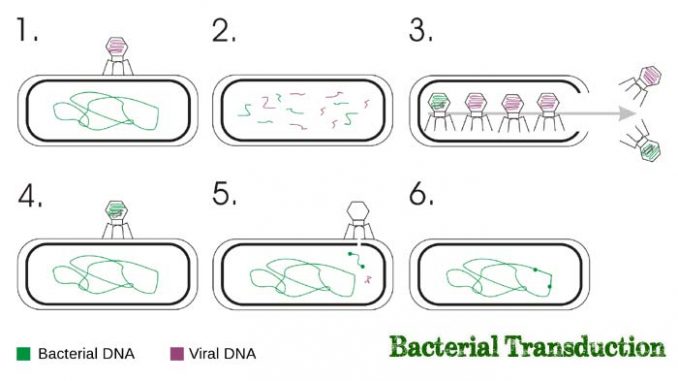
- Transduction is the transfer of gene or portion of DNA from one bacterium (donor) to another (recipient) mediated by a bacteriophage.
- In transduction, the bacteriophage at first infects one bacterium (donor) and some part of donor’s DNA is incorporated in bacteriophage which is carried into the recipient bacterium at the time of infection.
- The phase DNA undergoes lysogenic conversion inside the recipient bacterial cell and may confer pathogenic property in a non-pathogenic bacterium.
- Transduction is not only confined to transfer of chromosomal DNA but also to plasmids and episomes.
- Transduction is of following two types:
- Generalized transduction
- Specialized transduction
- Generalized transduction:
- If all the fragments of bacterial DNA from any region of the chromosome have the same chance to enter into the transducing bacteriophage, it is called generalized transduction.
- The viral DNA first begins the lytic cycle in the donor bacterium and hydrolyses the host DNA into small fragments.
- During assembly of the virus, any fragment of the host DNA (chromosome) can be incorporated into the viral DNA in its head.
- Such abnormal bacteriophages (those containing host DNA) infect the recipient bacteria and transfer this DNA into the new cell.
- Since this new DNA is not a viral DNA, it doesn’t replicate in the recipient cell but undergoes homologous recombination with the recipient chromosomal DNA.
- This occurs at a frequency of about 1 in every 1000 viruses.
- Generalized transduction can be of further two types:
- Complete transduction:
- It produces stable recombinants that inherit donor genes and retain the ability to express them.
- Abortive transduction:
- There is transient expression of one or more donor genes without the formation of recombinant progeny.
- The donor DNA fragment doesn’t replicate and only one bacterium contains the donor DNA fragment among the progeny of original transductant.
- The donor phenotype is finally unexpressed as the donor gene products become dilute in all progeny after each generation.
- The frequency of abortive transduction is typically 1-2 times more than that of generalized transduction.
- Complete transduction:

- Specialized transduction:
- The bacteriophage transfers only few restricted genes from the donor to the recipient.
- This transduction is carried out by the temperate bacteriophage which undergoes lysogenic cycle in bacteria.
- At first, the temperate bacteriophage enters into the donor cells and then its genome integrates with the host genome.
- Viral genome (DNA) integrates only at certain sites of the host DNA and upon induction from host chromosome, this phage genome sometimes carries host DNA with it.
- Only small parts of genes which lie at the sides of integrated phage DNA are carried with it and transfer that donor DNA into the recipient cell during infection of the new cell.